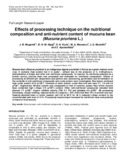Effects of processing technique on the nutritional composition and anti-nutrient content of mucuna bean (Mucuna pruriens L.)

View/
Date
2010-04Author
Mugendi, Beatrice J.
Njagi, E.N.M.
Kuria, E.N.
Mwasaru, M.A.
Mureithi, J. G.
Apostolides, Z.
Metadata
Show full item recordAbstract
Mucuna bean (Mucuna pruriens) is an indigenous legume promoted in Kenya as a green manure cover crop. It contains high protein but it is under - utilized due to the presence of 3, 4-dihydroxy-L-phenylalanine (L-Dopa) and other anti nutritional compounds. To improve its nutritional potential as a protein source, mucuna bean was processed and evaluated for nutritional composition. Effects of processing at different pH, temperature and particle size, autoclaving, germination and fermentation on the contents of anti-nutritional compounds and crude protein were investigated. Raw beans contained high crude protein (27.9 g/100 -1). Contents of ether extract; crude fibre and ash were 3.7, 7.9 and 3.5g/100-1, respectively. Mineral content was comparable to that of common pulses. Raw whole mucuna bean contained high L-Dopa (7.0 g/100-1) content. Other anti-nutritional compounds included totalphenols 7.1 g/100-1, trypsin inhibitor activity (TIA) 5.1 TIU and phytates 0.9 g/100-1. All processing techniques, except roasting, reduced levels of L-dopa by > 95% while less than 15% of protein was lost. Soaking dehulled bean in acidic medium (pH 3.2) at 60° C for 48 h reduced L-Dopa content to the recommended safe level of 0.1%. Processing mucuna bean increased its nutritional value and potential to improve food security.
URI
http://hdl.handle.net/123456789/2757https://www.researchgate.net/publication/267778821_Effects_of_processing_technique_on_the_nutritional_composition_and_anti-nutrient_content_of_mucuna_bean_Mucuna_pruriens_L
Collections
- Journal Articles (PAS) [285]
